Our Summer Cruise 2016
May 16 - 22 |
May 23 - 29 |
May 30 - Jun 5 |
Jun 6 - 12 |
Jun 13 - 19 |
Jun 20 - 26 |
Jun 27 - Jul 3 |
Jul 4 - 10 |
Jul 11 -17 |
Jul 18 - 24 |
Jul 25 - 31 |
Aug 1 - 7 |
Aug 8 - 14 |
Aug 15 -21 |
Aug 22 - 28 |
Aug 29 - Sep 4 |
Sep 5 - 11 |
Sep 12 - 18 |
Sep 19 - 25 |
Monday, August 29
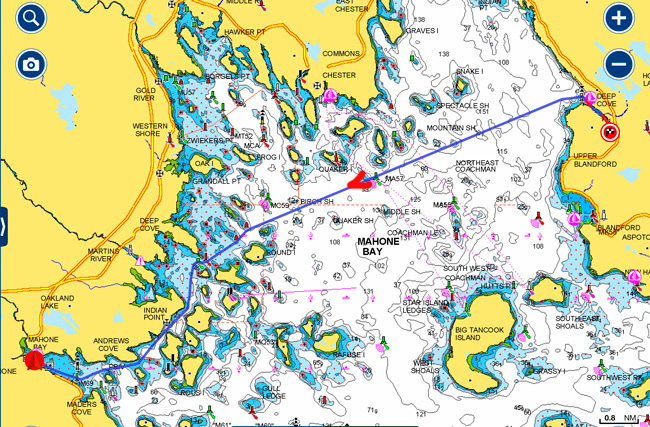
Deep Cove to Mahone Bay Town - 14nm
The start of our 16th week cruising this summer and well down the coast of Nova Scotia now. The chart below shows where we are on the planned trip. The solid line is ground (or water covered) and the dotted line represents water to go.
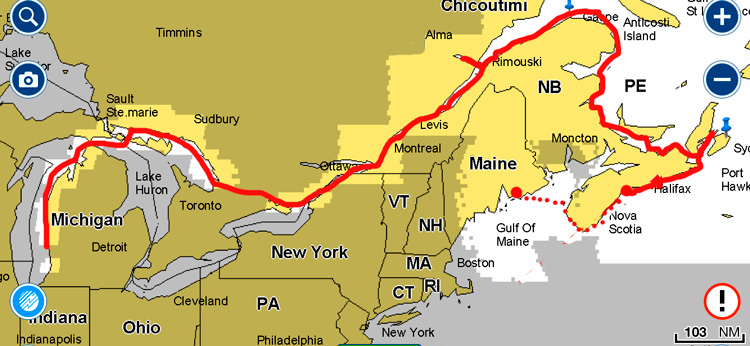
This Year's Route
After a quiet night at anchor, we were off early under grey skies for just a couple of hours run to Mahone Bay Town where we entered from the north past Indian Point, a small attractive fishing village, that is the home of Cheryl Barr, the author of the "Downeast Circle Route" cruising guide .... the "bible" for the trip. Many thanks to her for the work she has put into this book over the years.
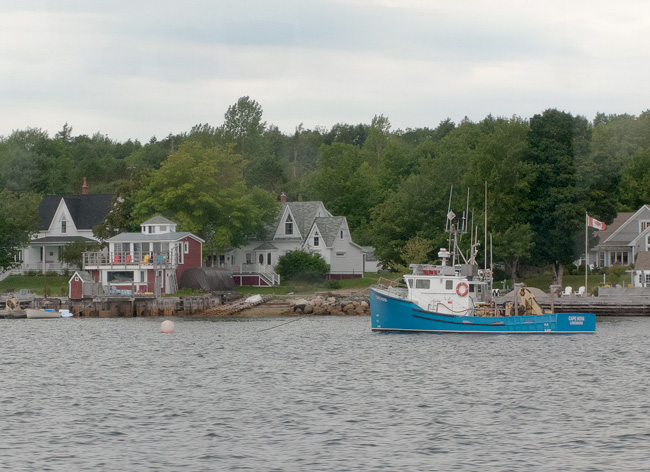
Indian Point
After wending our way though a series of small islands we approached the bay in which the town sits passing a very large sailboat, "Seaquell", a 110' yacht, the largest we have seen to date. It could be yours for only $4.6 million US.
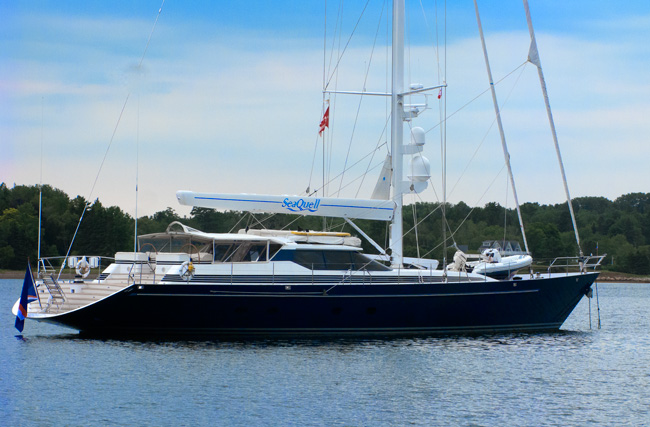
Mahone is one of the most scenic towns in Nova Scotia with its three iconic churches sitting at the head of the Bay.
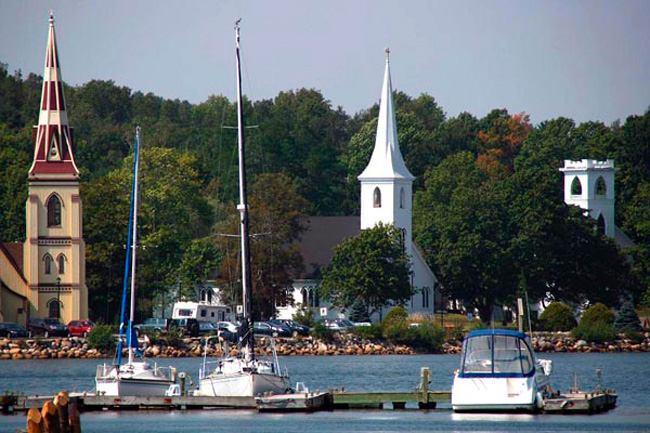
St. James (Anglican, St. John's (Lutheran), and Trinity (United)
The weather didn't look that great so we chose to tie up at the Public Wharf rather than getting a mooring; a bit rough around the edges but perfectly located in the town. We had a couple of loads of laundry to do so Judy took off to try to find a laundromat as no one at the dock had a clue if there was one. Down the street a ways, Judy asked a woman if she knew of a laundry ... "No, it had burnt down ... but we live just there and will be gone for the day, just use my machines and make yourself at home, watch TV, use the internet. We'll be back around 4:00pm." Now that hospitality takes some beating!!! Of course they were boaters. While the washing was going we had breakfast across the street, did some grocery shopping and explored the small town.
"Mahone" is derived from a French term for the speedy low-lying craft used by pirates to stash their booty in the area and escape the authorities during the early 1700s.
It was the British, though, who colonized the area in 1753 and brought European settlers to the lands of what is present day Lunenburg County. These hardy Protestant settlers, from Germany and Switzerland, farmed large plots of land in an area that was better suited for more marine-like endeavours. As time unfolded, and with true Germanic ethic, Mahone Bay became known for it's fine ship building yards and fishing fleets. At one time in the 1800s, there were over a dozen shipbuilders in the town launching over 100 boats of all types. And now, one doesn't have to go far to hear a German surname or the characteristic accent of the area.
On the darker side, Mahone was one of the leading importers of liquor during Prohibition and several shipbuilders built custom boats to outrun the US Coast Guard and police patrols. While I was out photographing the town in the evening, I met a couple and we got talking about our trip and the talk turned to the town history. The woman grew up in Mahone and she told me stories of late night meetings and bundles of cash completely covering their kitchen table. Unfortunately, her father had engine trouble off New York City coming back from the Bahamas with his boat loaded with liquor and he was "assisted" into port by the US Coast Guard where his boat, money, and cargo were seized. The family went from one of the richest to one of the poorest overnight!
Mahone Bay is a superb example of a town that has evolved with the centuries. Throughout the town, well maintained, century-old houses and buildings bear witness to the founders' legacy. Many are now Bed & Breakfasts, art studios, artisans' shops and eclectic boutiques, restaurants and cafés, all embracing that spirit of quality workmanship and service.
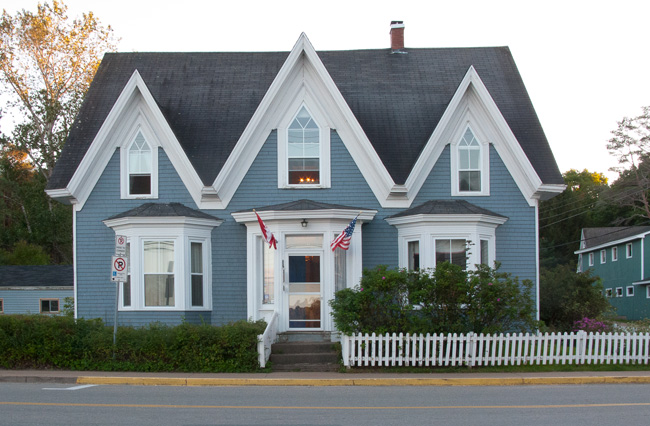
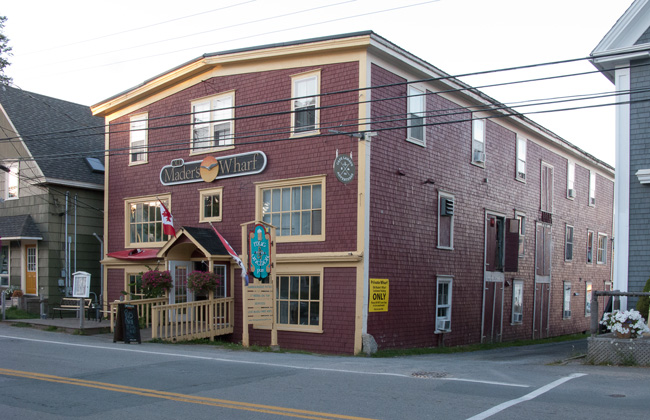
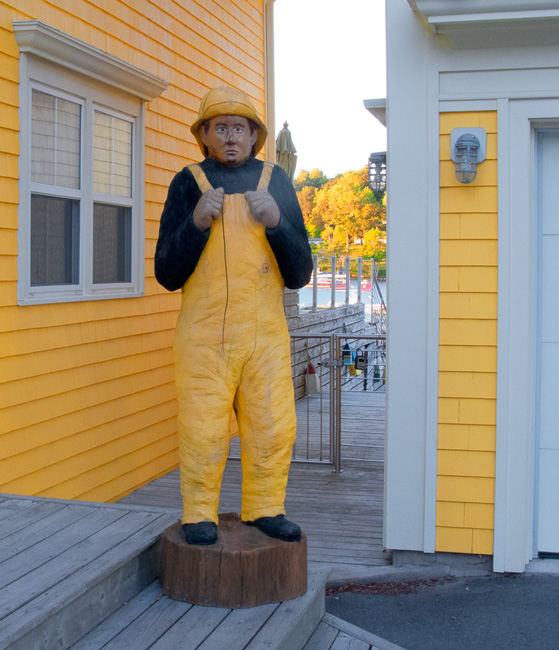
Where's Judy and Fran When You Need Them!
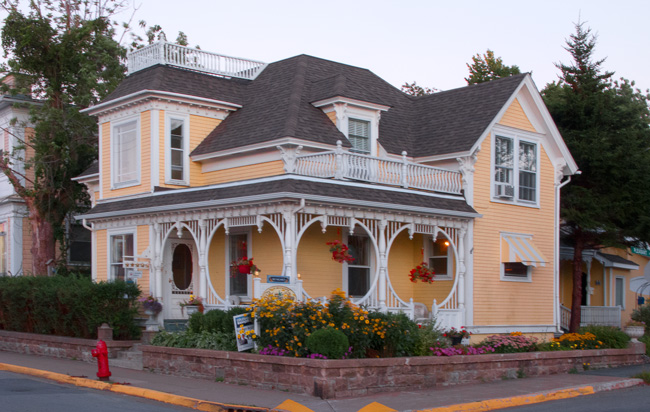
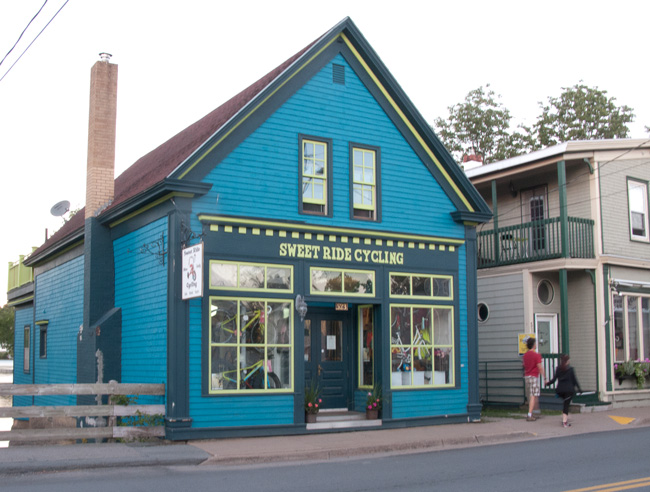
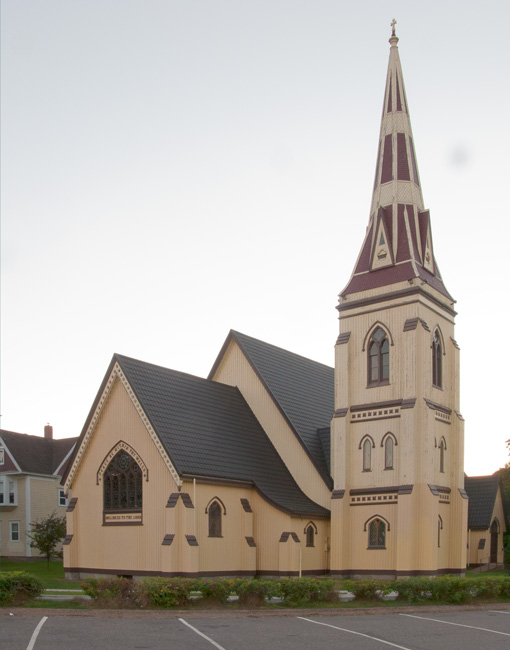
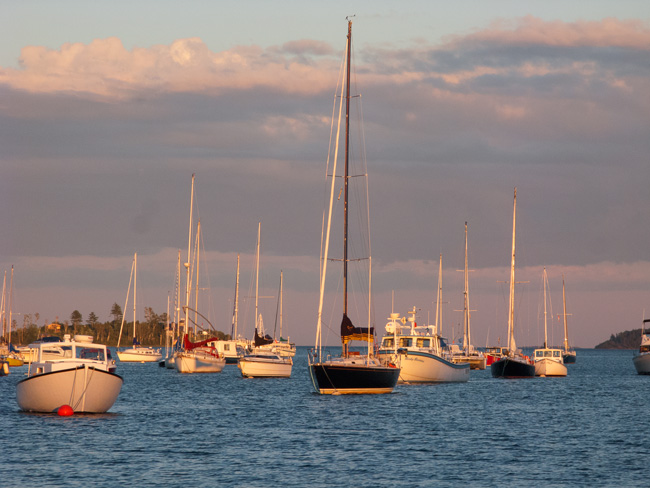
The Mooring Field at the "Golden Hour"
Tuesday, August 30

Mahone Bay Town to Lunenburg - 22nm
We had an easy run from Mahone Bay Town to Lunenburg under blue skies with relatively calm seas. Nearing Battery Point, we saw a schooner appear and begin to cross our path .... it was clearly the Bluenose II, a re-created version of the original famous Bluenose schooner.
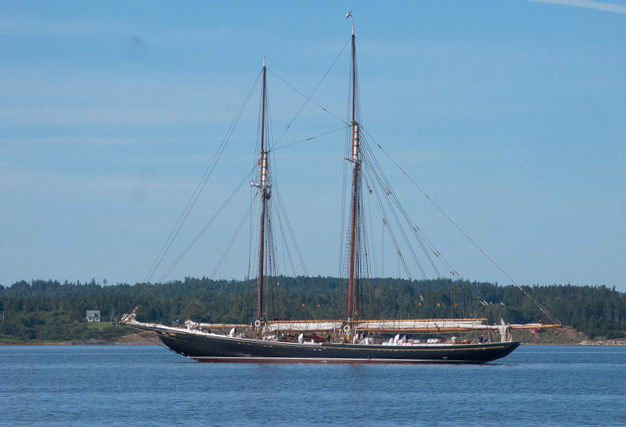
Bluenose II
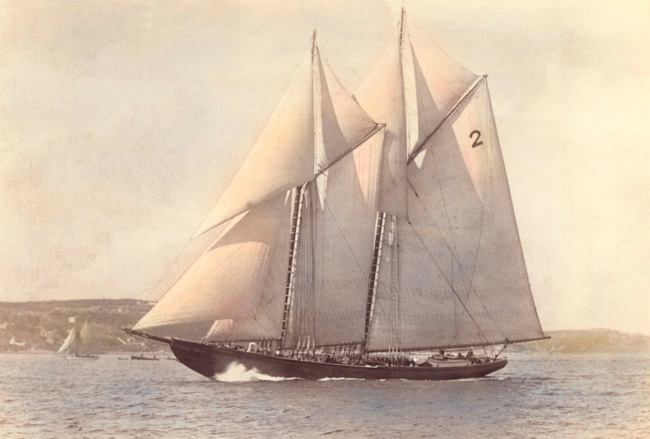
The Original Bluenose - 1921 - The Elimination Trials at Halifax
Bluenose was designed by William Roué and built by Smith and Rhuland in Lunenburg, Nova Scotia. She was launched on 26 March 1921 to begin a career as a racing ship and fishing vessel, in response to the defeat of the Nova Scotian fishing schooner Delawana by the Gloucester, Massachusetts fishing schooner Esperanto in 1920, in a race sponsored by the Halifax Herald newspaper. She was named after the nickname for Nova Scotians (not for the color of their noses in cold winters but a type of potato grown extensively in Nova Scotia).
After a season fishing on the Grand Banks of Newfoundland under the command of Angus Walters, Bluenose defeated Elsie (out of Gloucester), returning the International Fishermen's Trophy to Nova Scotia. In 1930, off Gloucester, Massachusetts, she was defeated 2–0 in the inaugural Sir Thomas Lipton International Fishing Challenge Cup by perhaps her most celebrated competitor, the Gertrude L. Thebaud. However, over the next seven years of racing, no challenger, American or Canadian, could take the title from her.
The Bluenose was no mere racing ship, but also a general fishing craft that was worked hard throughout her lifetime. She fished cod and other kinds of groundfish, and at least once won competitions for largest catches of the season and similar awards before becoming obsolete. Although efforts were made to keep Bluenose in Nova Scotia, she was eventually condemned to hauling bananas in the Caribbean before she was wrecked on a reef in 1946.
Bluenose is commemorated on the reverse side of the Canadian 10 cent piece.
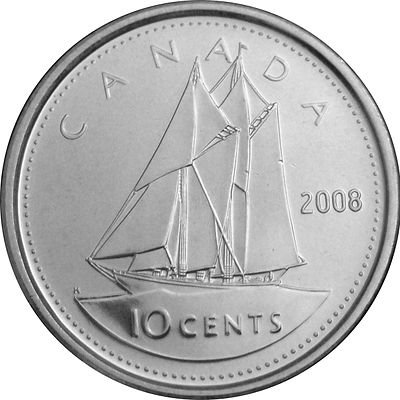
In a short while, we rounded the corner to get our first glimpse of Lunenburg's waterfront with colorful frame houses climbing the hill behind the water - spectacular!
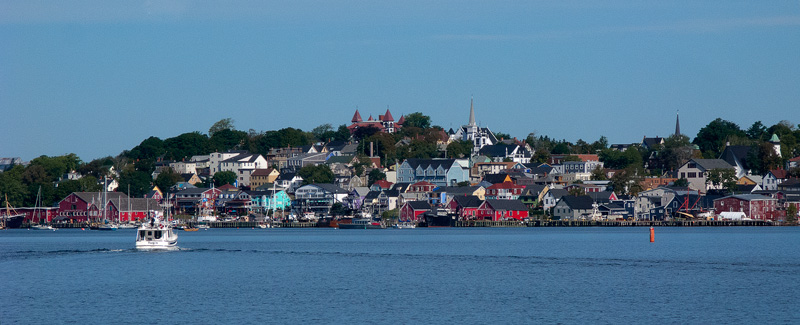
This town with its great history of fishing, shipbuilding and sailing, its harbour filled with many wooden schooners on moorings, is stunningly beautiful and deserving of its number 1 destination in eastern Canada. In 1995, it was designated an UNESCO World Heritage Site to preserve much of Lunenburg’s unique architecture.
The town was founded in 1753 as one of the first British attempts to settle 1400 Protestant colonists from Germany, France and Switzerland in Nova Scotia, intended to displace the Mi’kmaq and Acadian Catholics. The British settlement posed a lasting threat to Mi’kmaq and their sovereign, traditional territory. The town was subject to numerous raids by Acadians and Mi’kmaq, unsuccessfully attempting to regain control of their territory from the British.
Lunenburg is the best surviving example of a planned British colonial settlement in North America. Established in 1753, it has retained its original layout and overall appearance, based on a rectangular grid pattern drawn up in the home country. The inhabitants have managed to safeguard the city's identity throughout the centuries by preserving the wooden architecture of the houses, some of which date from the 18th century.
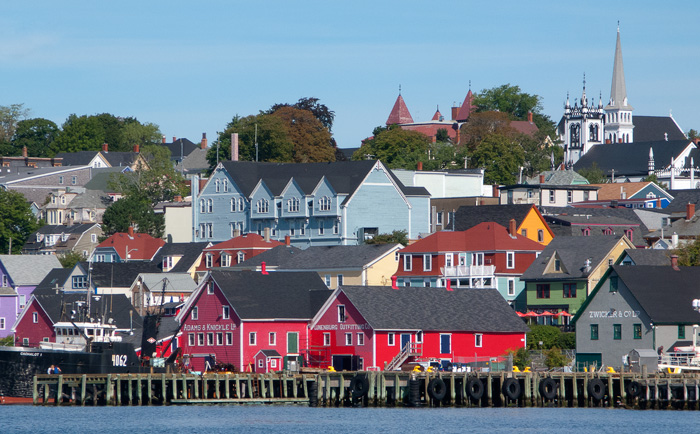
Today, Lunenburg continues to prosper through tourism, as a fishing port, and boat building and boat repairs.
Lunenburg has limited transient docking opportunities as almost the entire waterfront is taken up by commercial docks, fishing docks and repair facilities. Wings was fortunate to get a shore-side dock which Bob needed due to his limited mobility. We took a mooring buoy (not one of the rental ones as it turned out when we went to pay). We soon found the correct one amongst a number of beautiful wooden boats and set out to explore in the dinghy.
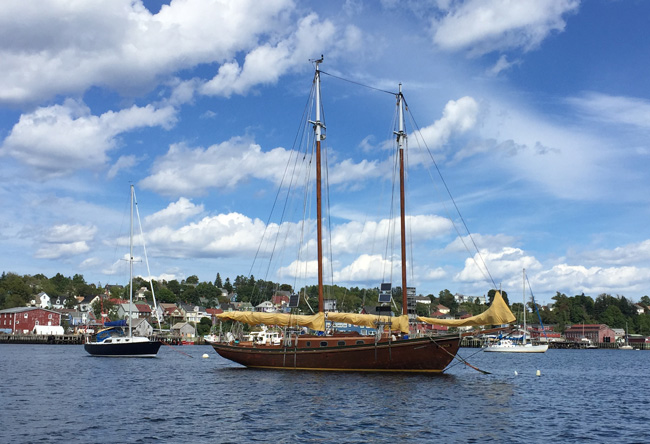
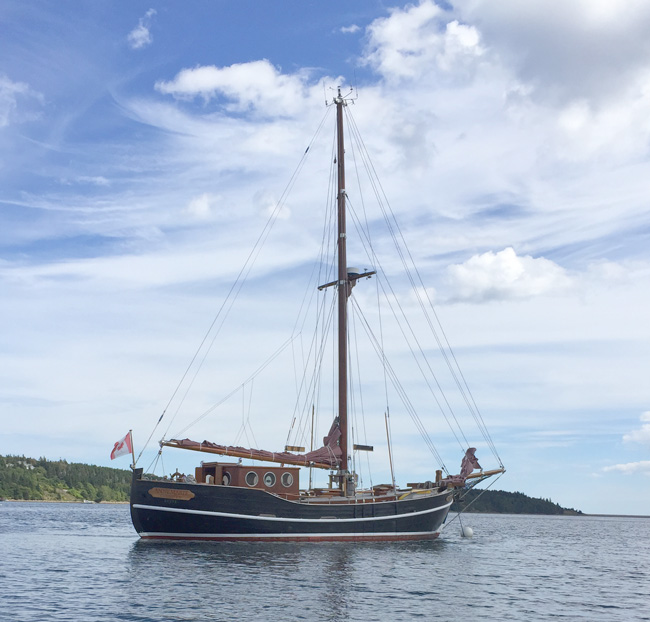

Pirates Only on this Mooring Ball!
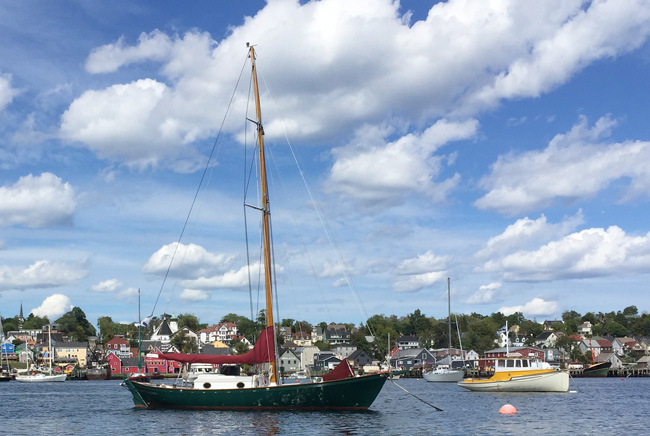
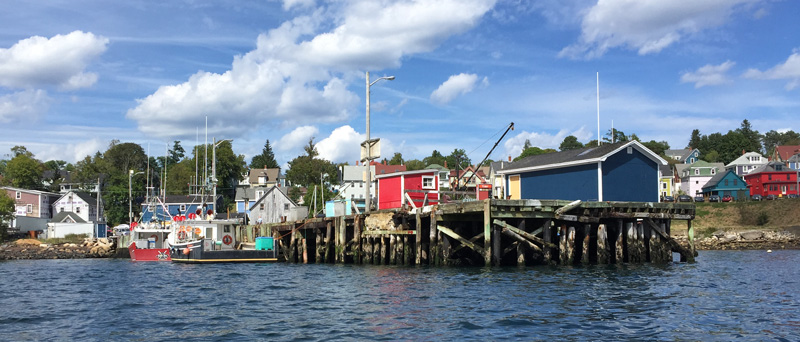
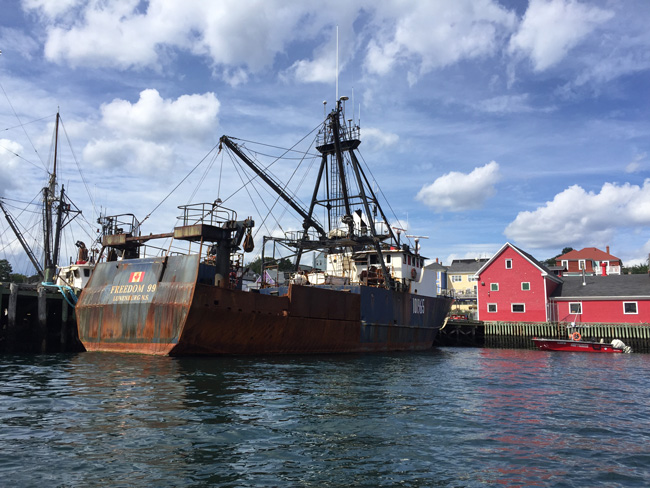
Not All The Boats Looked Pristine!
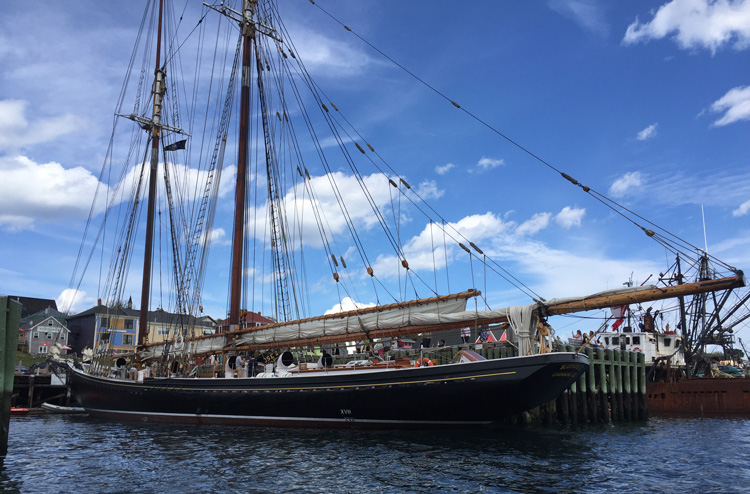
Bluenose II
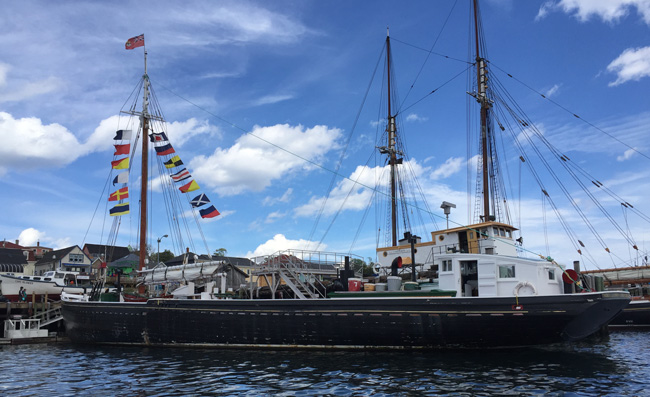
Theresa E. Connor - Lunenburg is Boat Heaven!
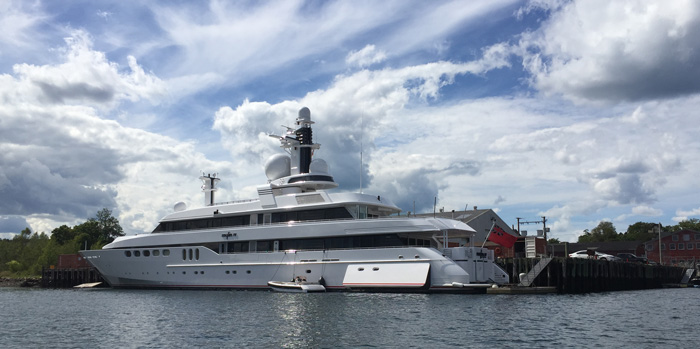
Not All the Boats Were Wood - This is the Biggest of the Trip - 200'
Owned by the Chairman of Carnival Cruise Lines
Being a great tourist destination, good restaurants abound and we partook of a particularly good one for lunch with the rest of the gang overlooking the harbor .... the local beer is very good as well.

Great Sunset Tonight
Wednesday, August 31
Today the weather cooperated again with blue skies for our visit to the Fisheries Museum of The Atlantic and its two boats, the Cape Sable and the Theresa E. Connor. The Museum occupied us for most of the day with an aquarium, models, artifacts and an excellent interpretive center showing visitors how fishing techniques had progressed from early pre-European times to the present day. We also got to launch a schooner down the slip ways into the harbor - well at least a 1/50th scale model but it was exactly how every schooner was launched!
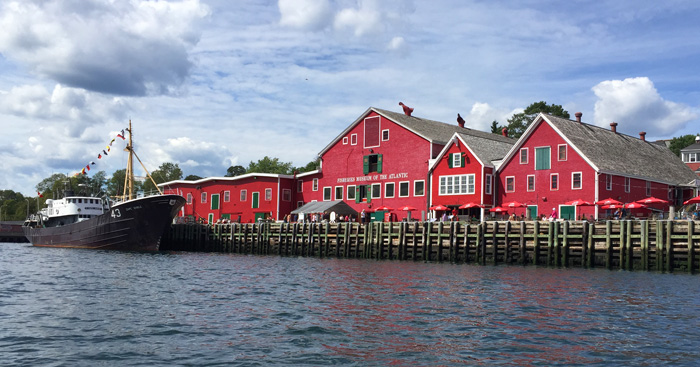
The Museum has an excellent staff to explain the exhibits and these were often former fishermen, scallopers, engineers, captains and fisherman's family members. With such experience, it made the visit much more interesting to get some first hand perspectives. We came away with a new respect for the work of the captains and crews of these fishing vessels.
We learnt that:
- a typical trip out was 10 days with 2 days back in port
- there was no fishing on Sunday
- if you whistled on board you were likely to get thrown overboard
- no women were allowed on the boat
- a boat would not leave on a Friday
- the crew was paid based on the catch value ... a bad trip or mechanical problems could result in lower pay. One instance was given where two successive trips netted less than $5 per crew member
- food was good with lots of calories (many from fat) but the crew needed it for 16 hour days in freezing conditions
- the union contract did not require crew to go out in greater than 50 knot winds unless they were overruled by the captain. Many of the fisherman named on the Fishermen's Memorial were the result of "at any cost" attitude.
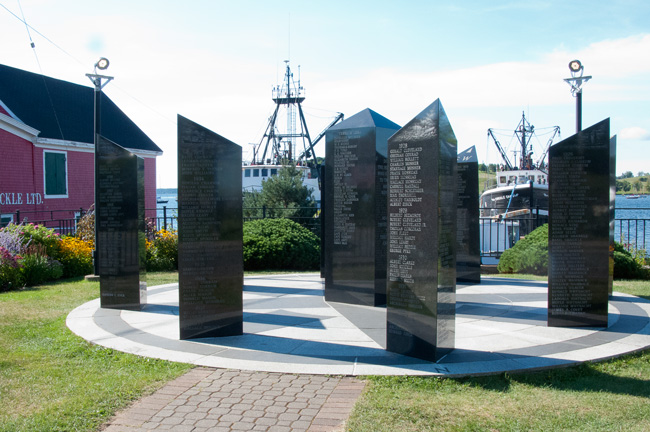
- In the early days, 1500s,1600s to 1700s, European boats fished cod on the banks off Nova Scotia using hand lines with baited hooks over the side; this was relatively inefficient.
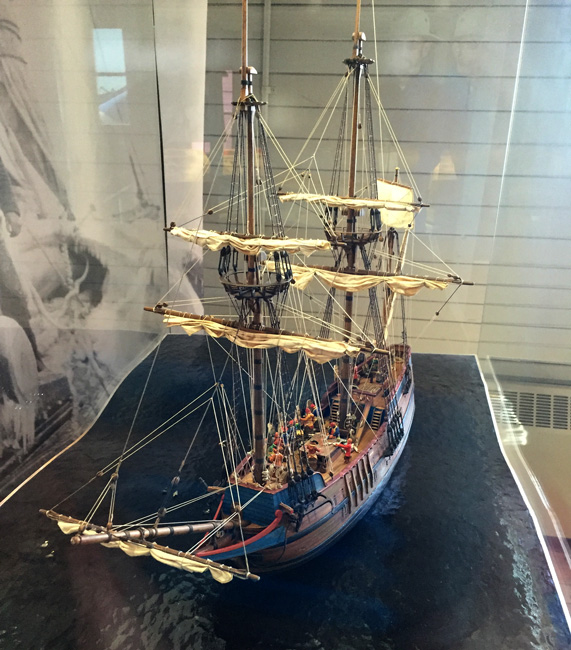
1650s Vessel
- Later the schooner evolved with a crew of 10-12, still single lining from the vessel.

1830s Schooner
- The next advance came with larger schooners that could travel quickly out to the fishing grounds and then deploy anywhere up to 12 two-man dories that did the actual fishing. Each dory was rowed or sailed to cover a wide area fishing with long hand lines that could hold hundreds of baited hooks. the crew was expected to fill the dory with up to 4000lbs of fish(usually cod) every few hours, row back to the schooner, unload the fish up to the deck and go back out. Six trips were not uncommon in all weathers.
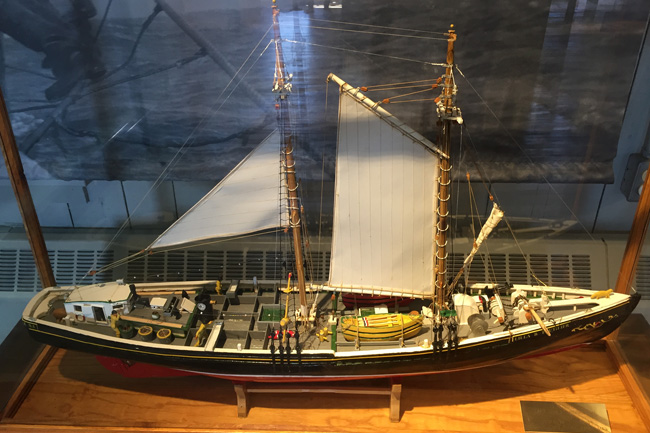
1900s Schooner with Dories
- Steam powered steel hull boats with side loader nets replaced schooners and finally, trawlers with stern loader nets came along.
- By this time, cod numbers were on the decline due to overfishing and it was too late to save the industry. Too late, the federal government shut it down in 1992 putting some 40,000 fishermen and fish processing plant employees out of work. The rich banks off Nova Scotia and Newfoundland were a wonderful natural resource that provided an enormous bounty of fish for almost 500 years but man often does not know when to stop a good thing.
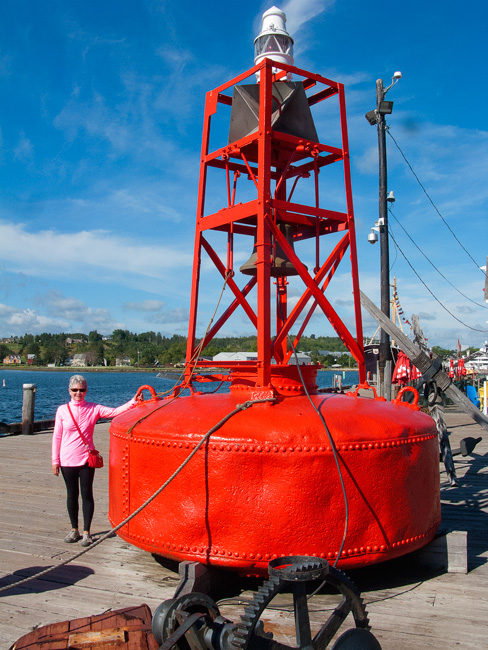
Large Ocean Buoy With Bell, Radar Reflector and Flashing Light

Typical Nova Scotia Long Line Fishing Schooner
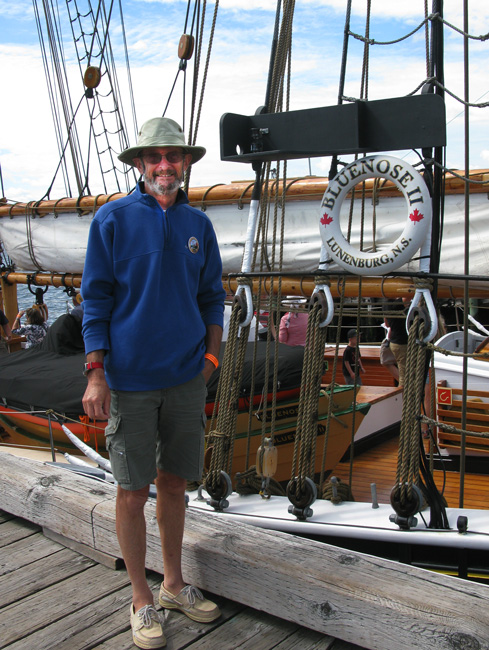
Bluenose II
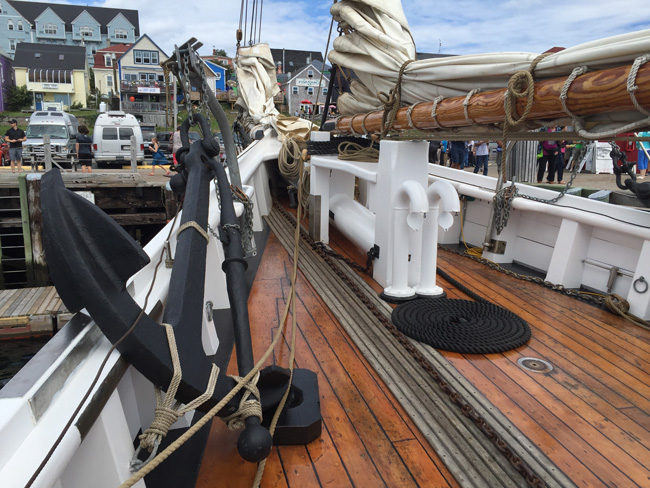
Bluenose II Foredeck
We toured the two museum boats, first the older Theresa E. Connor (see earlier photo) then the Cape Sable. The flagship of the Fisheries Museum of the Atlantic, Theresa E. Connor is Canada’s oldest salt bank schooner. Built in 1938 in Lunenburg, at the Smith and Rhuland Shipyard made famous as the birthplace of the original Bluenose, the vessel fished as a dory schooner for 25 years. During that time the crew used double (two-man) dories and fished with long trawl lines of baited hooks. It's last trip was in 1963 when the Captain was unable to raise a large enough crew to risk life and limb for fish when the much safer trawlers were available.
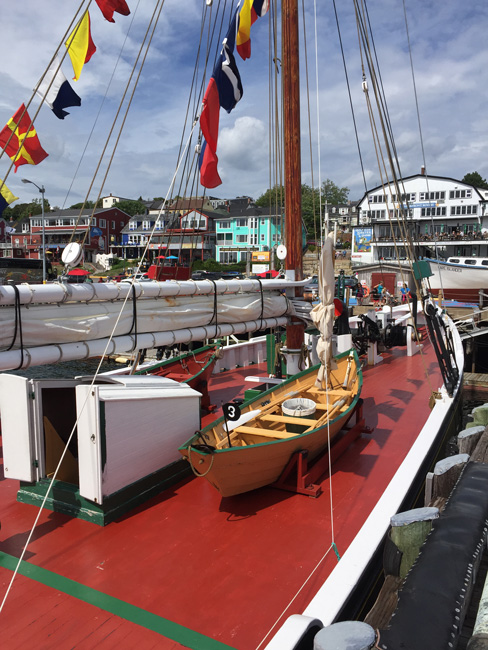
Theresa E. Connor Deck
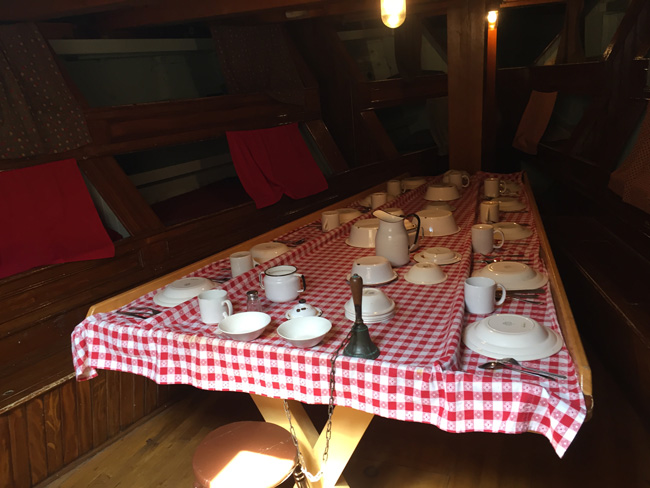
Galley and Crew Quarters
Cape Sable is a steel-hulled side trawler, built in 1962 at the Boot-Leiden Shipyard, Leiden, Holland. Nets were lowered over the side and towed out to the sides of the vessel. The catch was hauled aboard, processed and iced down. The trawler is the style of vessel that eventually replaced dory schooners like the Museum’s Theresa E. Connor. Cape Sable fished for National Sea Products Limited for twenty years and retired in 1982, having been replaced by larger stern trawlers. Unlike fishing schooners, which could be away from home for a month or more at a time, an average trip aboard Cape Sable lasted eight to twelve days. Total fishing capacity in the hold was 300,000 pounds of fish.
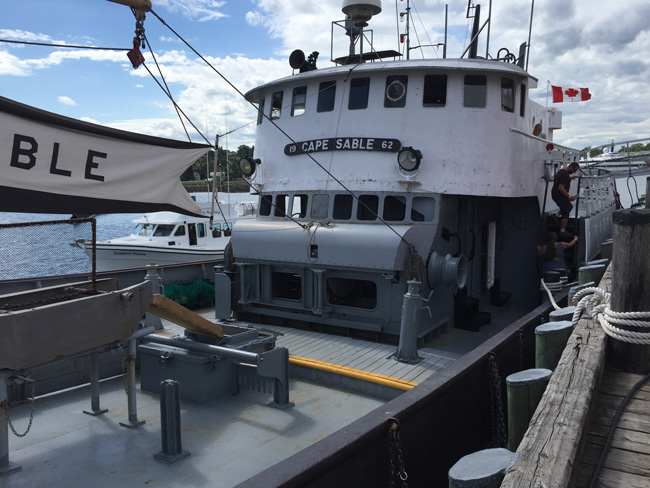
The larger stern trawlers and factory freezer trawlers which took over were only in service for a relatively short period before the fishery died and they were not longer economic.
While on the Cape Sable we noticed the following almost unbelievable story.
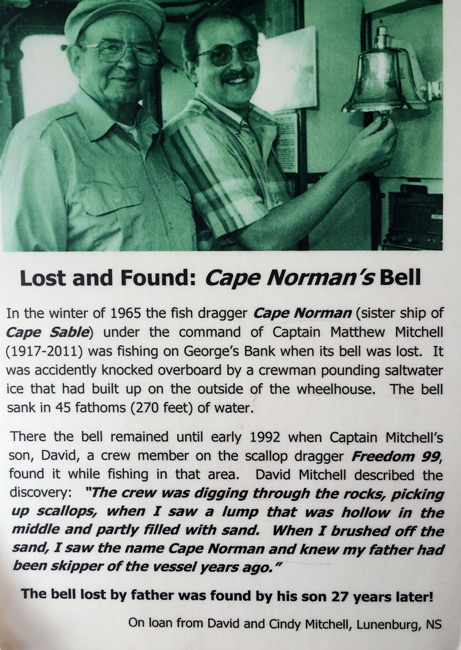
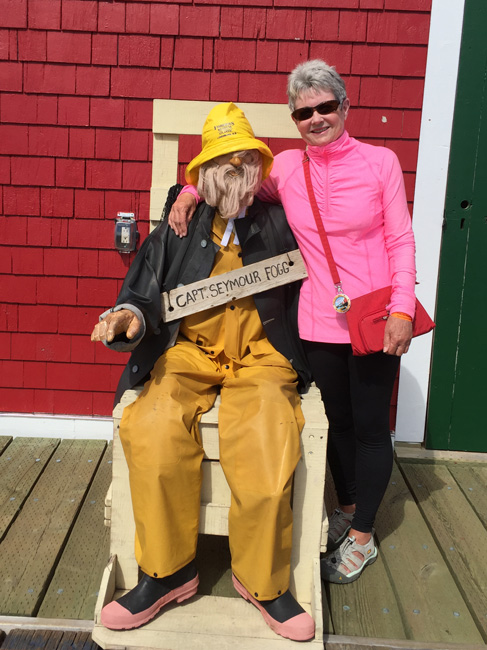
Where are You Fran!
We capped off the day with a walk around the upper streets of the town around the church area where we visited St. Johns Anglican Church, one of several in the immediate area. The church, original built in 1754 and subsequently remodeled in the 1800s is notable for a fire in 2001 than destroyed almost half of the building.

Within four years, the church had been rebuilt to its original condition (and better) ....
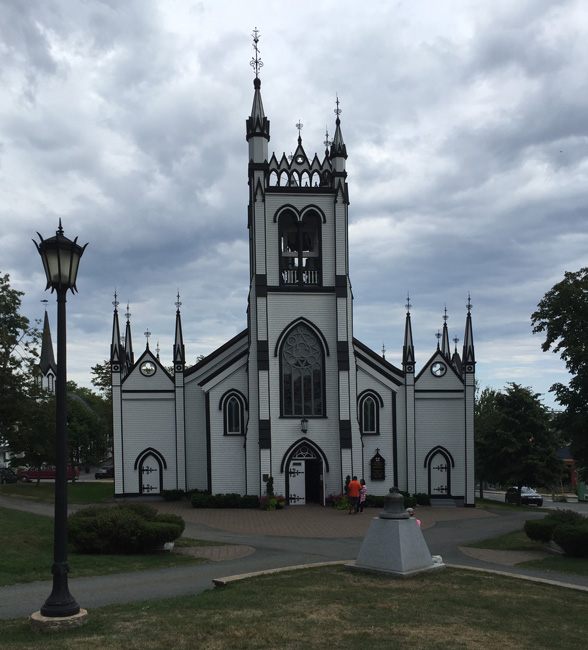
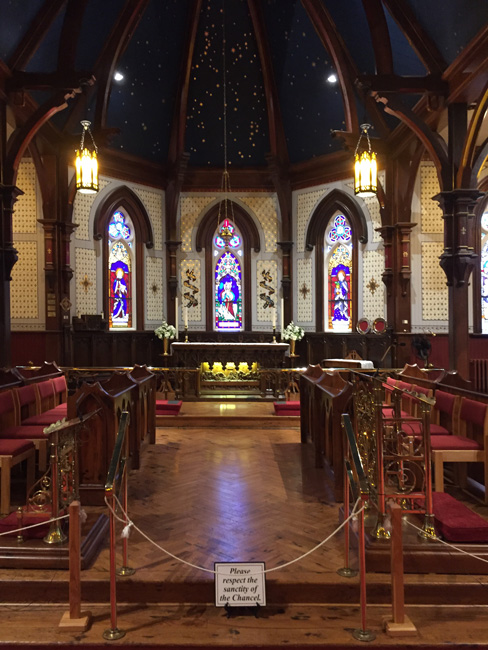
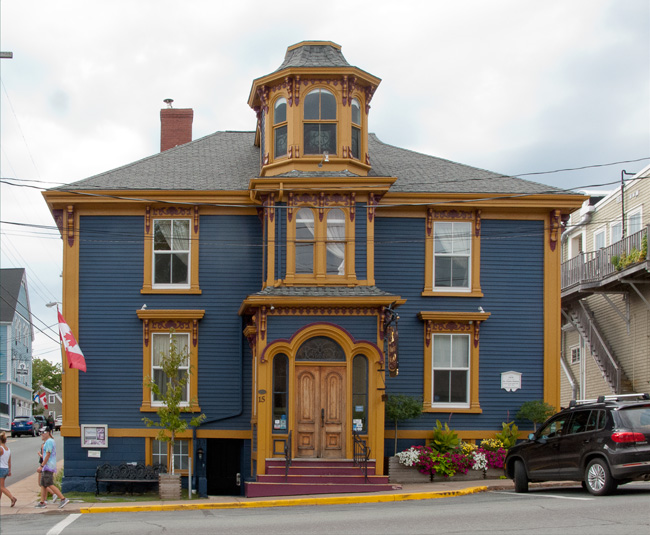
One of Many Fine 19th Century Residences
As we were dinghying back to the boat after a long day, who did we see but Sammy the seal again. He will miss us when we are gone!
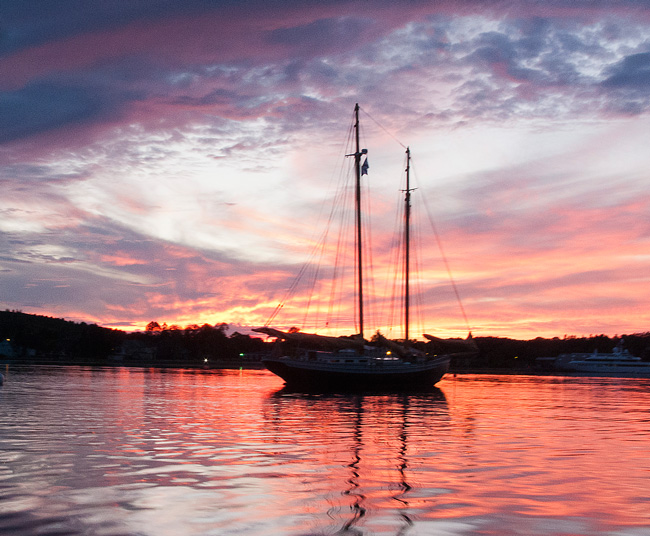
End to a Great Day
Thursday, September 1
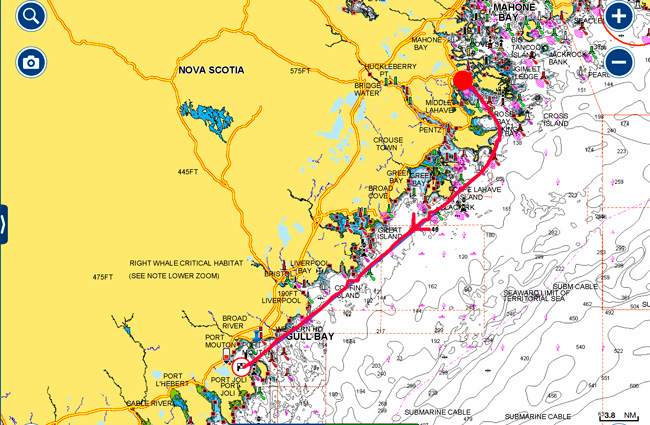
Lunenburg to Port Mouton (muh-toon) - 48nm
Today was a little overcast as we dropped the lines securing us to the mooring ball overboard and left for Port Mouton, more specifically nearby Carter's Beach, reputed to be the best beach in Nova Scotia. Another place named after Jacques Cartier ... he was a busy boy! As we were making our way along the coast, we had several humpback whale sightings and also a few dolphins. They must like the cooler water which is now down to 55 deg. F.
The guidebooks didn't lie about this anchorage which has three crescent-shaped white sand beaches separated by a rocky spit and a small stream only inches deep at low tide. We anchored in 15' of water and could watch the anchor drop to the bottom and set in the sand as we pulled back. While it was little overcast, it was easy to imagine that in full sun this anchorage would look Caribbean with the sand dunes backing up the beach.
The water was even colder, 52 deg. F and it is reputed to never get warmer than this. Nevertheless, there were a number of kids swimming (they must not feel the cold!).
We dinghied ashore and beached the dinghy up as far as we could. The tide was falling at this time so we just took a short stroll along the beaches and waded up to our knees which was plenty for us with blue feet after a few minutes.
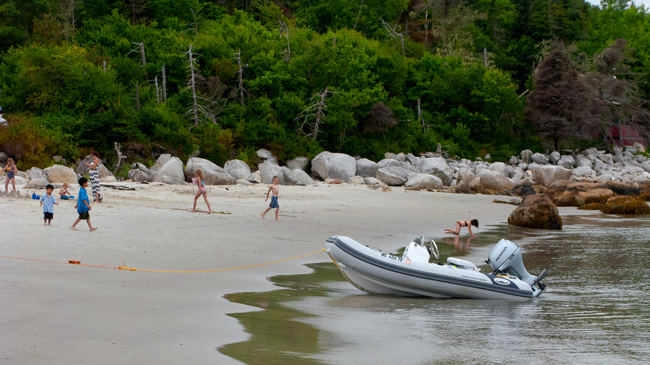
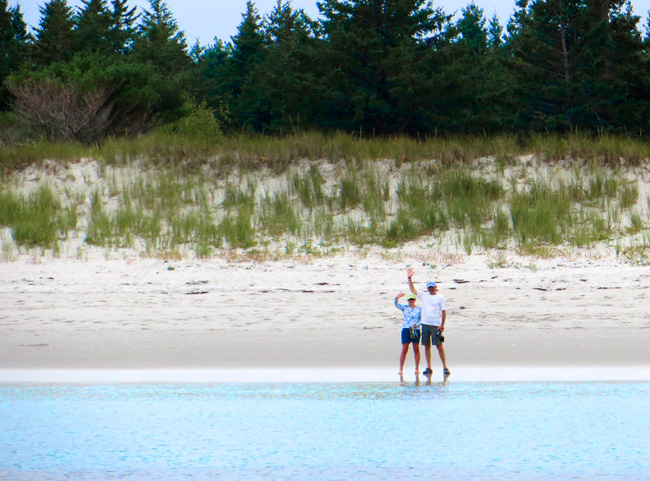
Waving to Tug'n and Wings
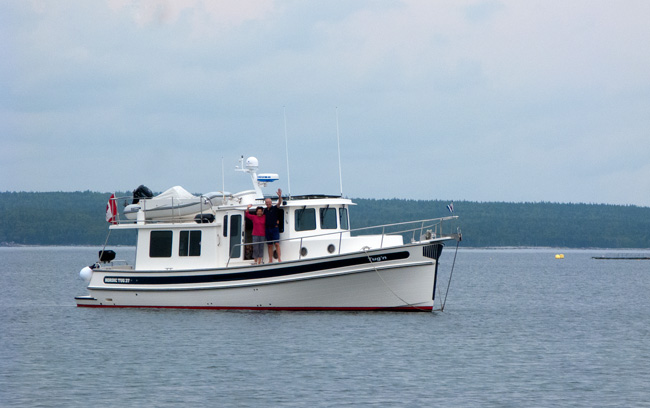
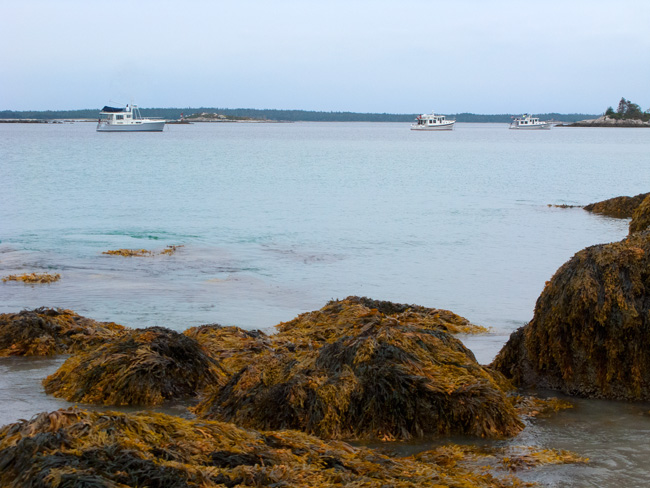
With a struggle we got the dinghy back in the water as the tide had fallen about 9; another hour would have been a really tough job. We have read stories on blogs of people having to wait hours for the tide to turn to be able to re-launch a heavy dinghy like ours. Need to come up with a creative way to anchor off - Google must have some ideas.
As we returned to STB, we noted a guy off by the rocks with a long handled rake working the bottom and thought he was scalloping so we drove over to see what he was doing.

Talking with him, we managed to make out through a thick accent that he was collecting Irish Moss, a type of seaweed that he sold to a processing plant in Port Mouton. Irish Moss is an industrial source of carragheen, which is commonly used as a thickener and stabilizer in milk products such as ice cream and processed foods, including lunch meat. Irish moss is commonly used as a clarifying agent or finings in the process of brewing beer, particularly in home brewing. A small amount is added to the kettle or "copper" where it is boiled with the wort, attracting proteins and other solids, which are then removed from the mixture after cooling along with the copper finings.
Irish Moss is not very common and the Nova Scotia coastline is one of a few sources.
Not only was Carter's Beach beautiful, this evening we had a spectacular sunset with the whole sky vivid reds, oranges, and yellows reflecting on to the water.
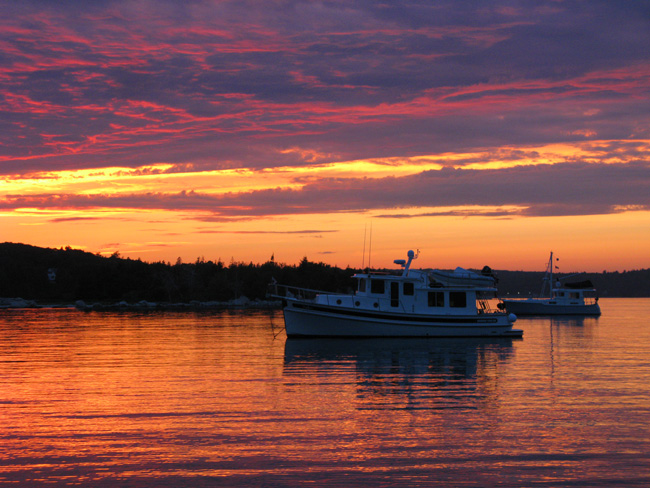
Friday, September 2
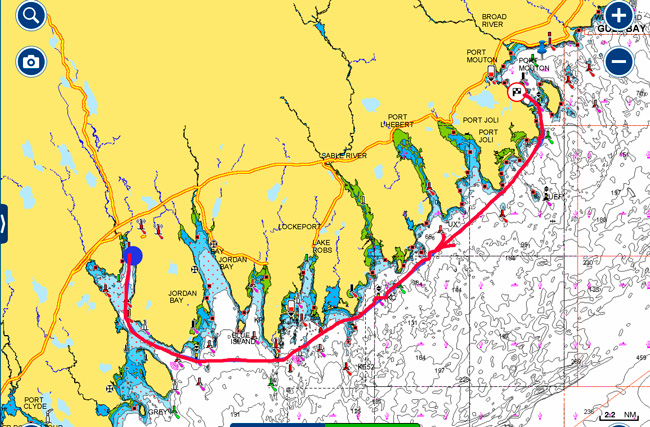
Carter's Beach to Shelburne, NS - 40 nm
After a careful reading of the Cruising Guide to Nova Scotia, we found our way through the shallow channel to leave Carter's Beach by the western route which saved a few miles and were on our way in relatively calm seas for Shelburne, possibly our crossing point to the USA. An uneventful day, arriving in the early afternoon at the historic town of Shelburne to grab a mooring ball at the Shelburne Yacht Club.
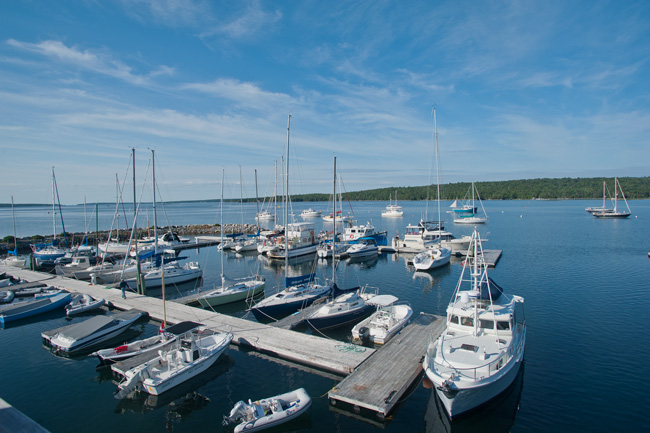
Shelburne Yacht Club and Marina
The Club has a well-protected set of docks for those who want them and good set of mooring buoys. They have good facilities such as showers and laundry and, on the upper level, a large bar/restaurant where an outside organization has a limited Friday night menu of seafood and beef dinners. Luckily it was Friday so our dinner was taken care of and it was very good and inexpensive.
Like many Clubs, Shelburne has an extensive collection of yacht burgees donated by visiting boats and amongst them, one stood out ... the Corinthian Yacht Club in Chicago. Dean Rafaelli, our friend from Chicago is a member of this small club.
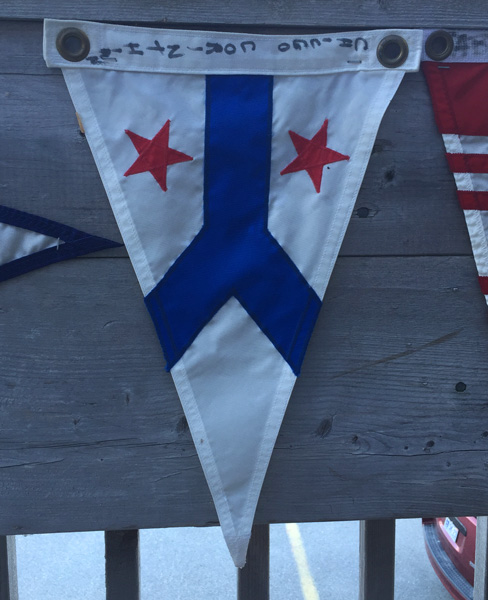
Shelburne is the home port of Peter Loveridge, the author of "A Cruising Guide to Nova Scotia", and they were selling his new edition on DVD so we took the opportunity to pick one up. Peter was on his boat and we sought his advice on when and where to cross to the USA based on the current weather. He graciously took time to sit down with us and spend an hour reviewing our options and giving his recommendations. Tomorrow is the day and Shelburne to Northeast Harbor is the route. Although I took notes, later when we discussed when to leave to get the favorable current, we somehow misinterpreted the notes and picked 1:00pm based on the Navionics currents. No big deal as it turned out.
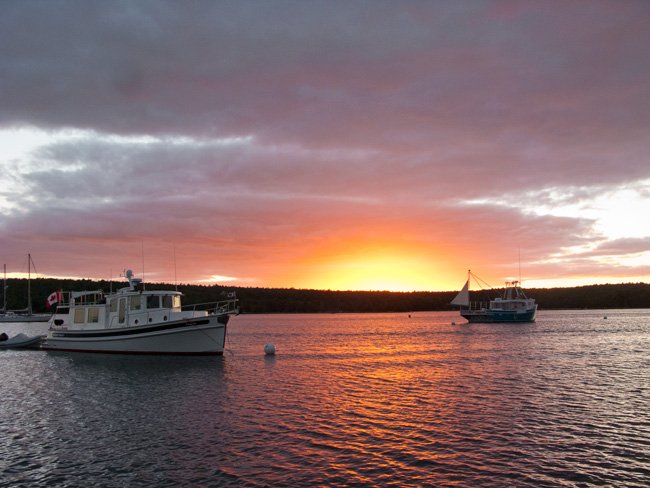
Tug'n at Sunset
Saturday, September 3
Beautiful day again in Shelburne. We had the whole morning off to wander around the historic part of the town and visit the Farmer's market before getting underway at 1:00pm for our crossing from the town to Northeast Harbor, Maine, USA.
During the American Revolution, pro-British refugees gathered in New York. The wealthier classes went to England while others sought refuge in Nova Scotia. In 1783, four hundred such families founded the town of Port Roseway. The first Governor, Parr, renamed the town Shelburne after the current Prime Minister, Lord Shelburne. Within a year, the town's population mushroomed to 10,000 and the region could not support such a large settlement and many of the refugees moved back to England, to other parts of the Province or to New Brunswick while others returned to the USA.
Much of the historic old town has been well preserved as either homes or repurposed. The Yacht Club was originally part of the old town.
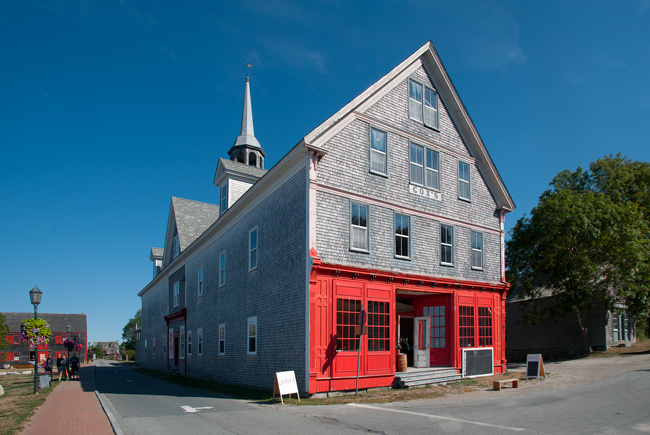
Cox's General Store - Now a Potter's Studio

John Williams Dory Shop
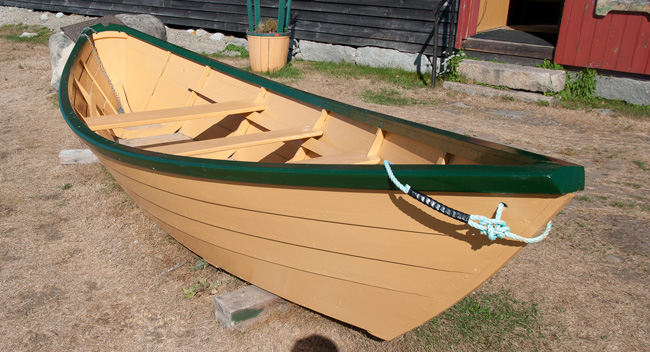
Dory in Traditional Colors
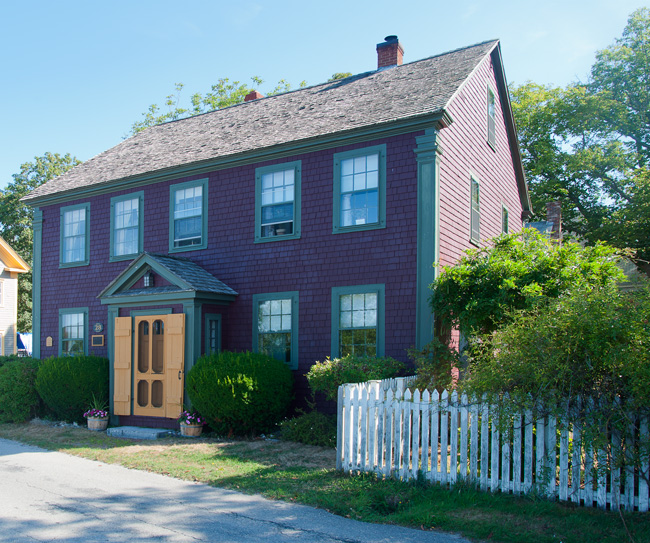
McDonough - McLean House 1785 - Just One of Many From the 18th Century
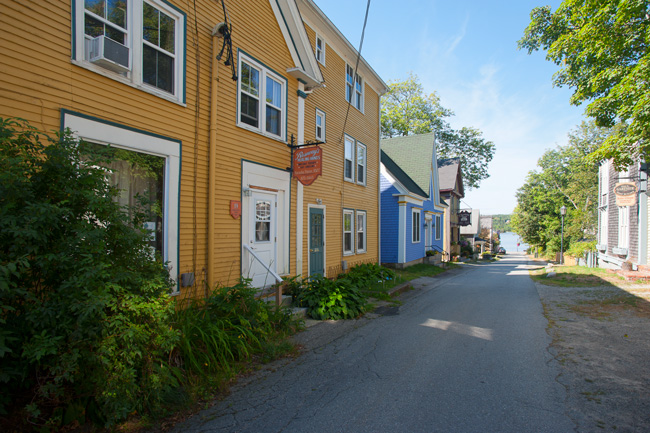
One of the Main Streets in the Old Town
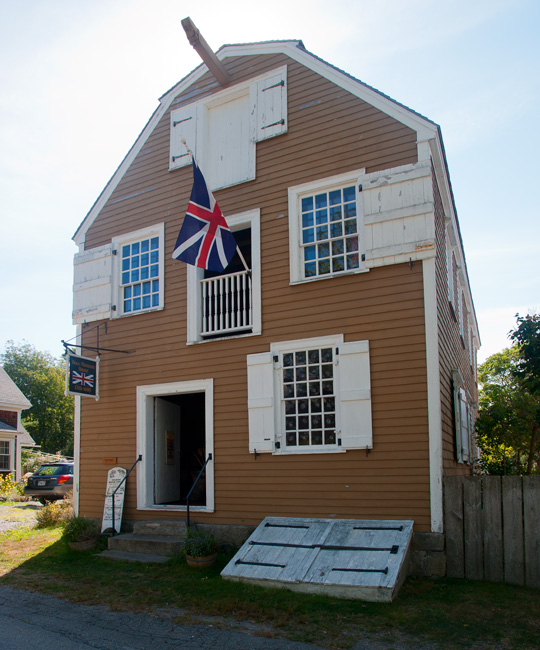
Ross-Thomson House - 1785
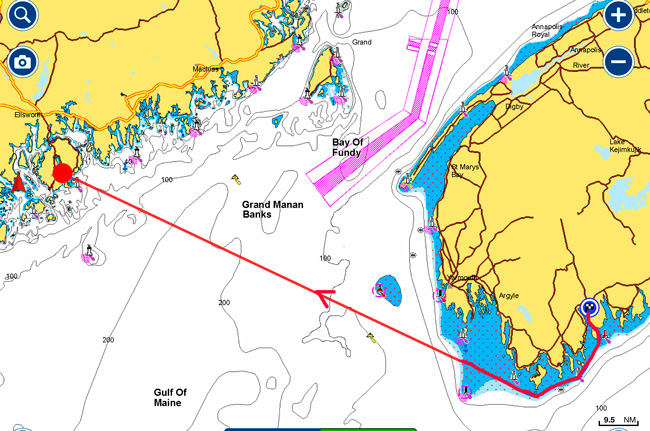
Shelburne, NS to Northeast Harbor, ME, USA - 167nm
We left Shelburne as planned at 1:00pm under perfect conditions and slowly made our way towards Cape Sable, the turning point for the crossing with arival planned around 6:00am. I had only one made one overnight crossing before in our sailboat and Judy had never done one, so we were a bit apprehensive but at least the weather was in our favor.
Slowly the major landmarks passed as time crept slowly on past the rugged coast of southwestern Nova Scotia - not a place to be in a storm....

This area of the coast has the highest concentration of lighthouses
and the now-obsolete LORAN navigation station at Cape Negro. For many years, LORAN was the only "electronic" navigation system available to commercial and recreational boats. The Global Postioning System (GPS) eventually made maintenance of LORAN uneconomical and the system was phased out by 1985.
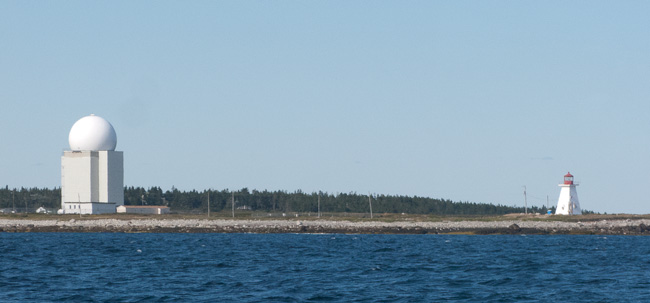
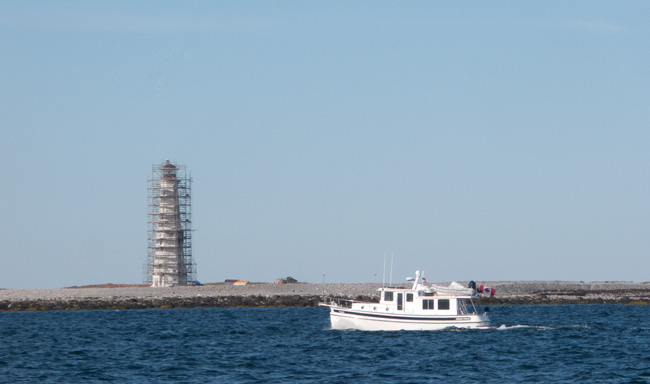
Tug'n passing Cape Sable Lighthouse (girded in scaffolding)
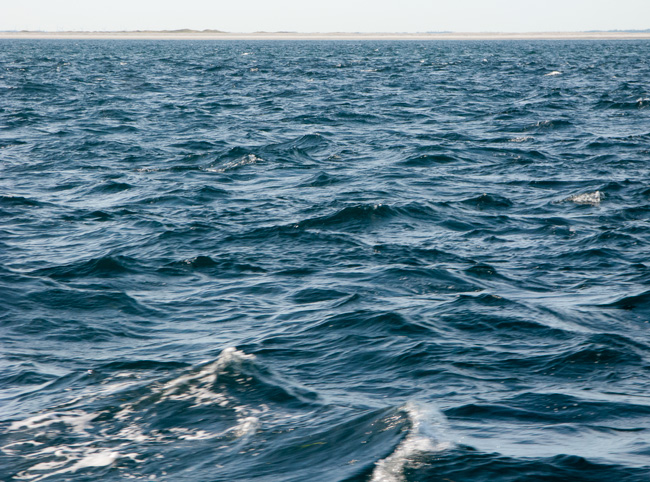
The Worst We Saw in the Daylight
Darkness fell around 7:00 and we were treated to an amazing sunset as we headed west.
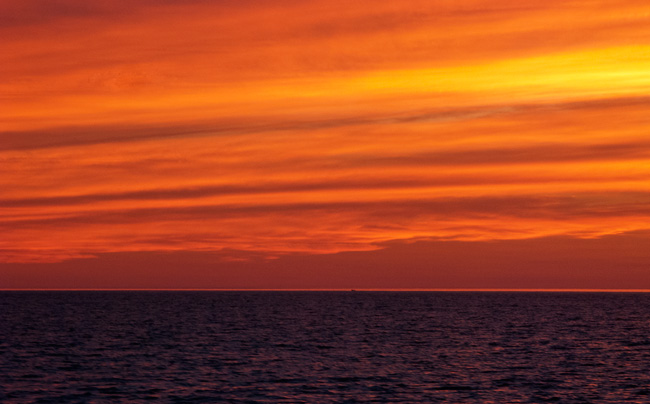
Into The Sunset
With all our internal lights off to preserve our night vision and instruments either dimmed or in "dark" mode we soon got used to not seeing much outside of the boat. As we got used to the darkness for the next hour, we gradually started to make out what the water was doing nearby ... not much! We were in frequent contact with the rest of the group as we were setting the pace which we had to continually adjust down as we were going to get there too early. The projected push from the tide moving into the Bay of Fundy did not occur and we only saw a knot or so in our favor - better than against us.
Judy took a break to rest while I stood watch until Midnight but she didn't sleep much, must have been the lack of excitement. At Midnight, Judy officially took over and I went down to the salon for my three hours off watch.
Sunday, September 4
Sunday for us began at 12:00 midnight today and we were somewhere in the middle of the Gulf of Maine heading north northwest in pitch darkness. Neptune was still being kind to us only poking up 1ft. waves at us and blowing a light breeze. The slight current push we had earlier had dissipated and we were making good progress to meet our goal of being about 15 miles of the coast of Maine by sunrise. Checks every hour showed our average speed was a little high so we cut our speed to 7.5 kts; we did not want to arrive early. There was very little traffic out there tonight and we only had a few glimpses of lights and some radar hits. One mysterious one stayed with us for a number of miles about a mile off our stern corner. The other boats also picked it up - I believe it was our wakes showing up as the water was relatively flat.
We kept cutting our speed down and, at one point, were down to 6.6 kts but timed it right in the end with the sun rising behind us as STB was the first boat to spot a lobster pot float at about 18 miles from shore.
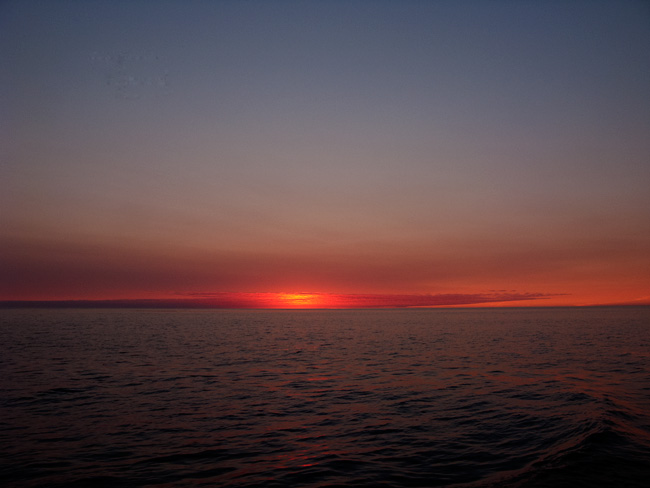
A Beautiful Sight Behind Us!
From this point on, the number of floats increased with every mile as we ran a slalom course with no point in trying to use the autopilot. We hand steered for the next three hours with constant zigging and zagging while trying to maintain a general direction for Mt. Desert Island in the distance. We were pretty tired by the time we made the turn in to Northeast Harbor and tried to get a mooring ball (none available). The alternative - a floating dock sounded promising and we got assigned to one that looked like four floating wood pallets with a flock of cormorants staking it out. We pulled alongside and thought better of it and were assigned a better dock.
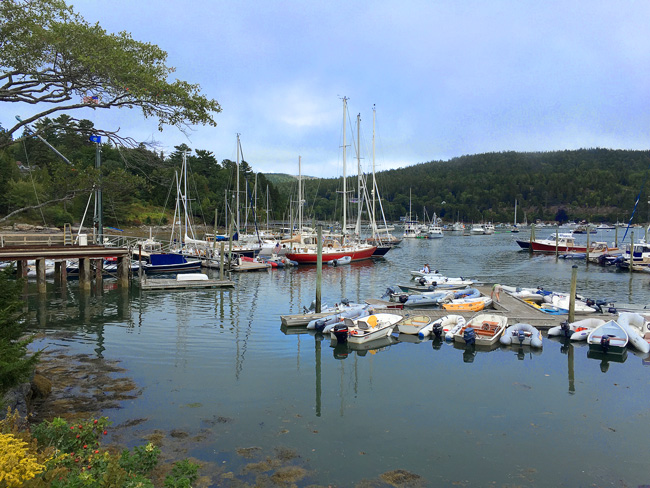
This was our first experience of this type of dock. It was a 40' long dock about 4' wide floating in the middle of the water and presumably anchored to the bottom with a couple of large rocks; like a mooring buoy but you tied up alongside.
At this point we didn't care too much as we were quite exhausted and just crashed for the rest of the day, waking up later in the afternoon and feeling quite good. We missed a good weather day but sleep was more important!
In retrospect, although we had mistimed our departure, we were very fortunate to have had almost perfect weather for our crossing and our first overnight together. If we had received the expected current push from the tide, we would probably have arrived two hours too early or would have had to run at 6 kts for most of the night. Leaving a day or two later would not have been a good idea and even Tuesday turned out to be quite rough out there; Wednesday and Thursday were smoother but very foggy ... dodging lobster pots would have been very tough!
May 16 - 22 |
May 23 - 29 |
May 30 - Jun 5 |
Jun 6 - 12 |
Jun 13 - 19 |
Jun 20 - 26 |
Jun 27 - Jul 3 |
Jul 4 - 10 |
Jul 11 -17 |
Jul 18 - 24 |
Jul 25 - 31 |
Aug 1 - 7 |
Aug 8 - 14 |
Aug 15 -21 |
Aug 22 - 28 |
Aug 29 - Sep 4 |
Sep 5 - 11 |
Sep 12 - 18 |
Sep 19 - 25 |
